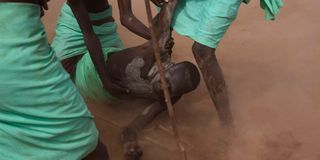Saying no to traditional practices that burden men and boys

Initiates during Ilchamus community traditional rite of passage called Sayiare, which prepares boys for circumcision. It involves running and walking long distances in show of endurance by the young men.
What you need to know:
- A 2019 study decries the scant attention paid to harmful traditional practices against men and boys.
- While male circumcision is ordinarily not classified as harmful, and is even recommended for HIV management, it constitutes violence in certain contexts.
The case of an Uasin Gishu boy who died as a result of infection from circumcision in December last year raises the question of harmful traditional practices against men and boys.
More so, are reports of action by county security committees in Murang’a, Kirinyaga, Embu and Kiambu to protect boys from a practice called gwithamba mbiro – washing off the soot, in which newly circumcised adolescents prospect for sex, including with commercial sex workers, to “cleanse” themselves (Daily Nation January 4, 2023).
Sexual activity with anyone below 18 is an offence. Thus, the commercial sex workers are committing crime. Whoever finances the boys to pay for the services is equally guilty. Chances of addiction to commercial sex are high as the boys learn that sex can be bought. Moreover, those who cannot afford it may become rapists. The boys are also exposed to sexually transmitted infections, inducted into sexual permissiveness and socialised that women are sexual objects.
Lineage
A 2019 study by Emmanuel Amoo and others, decries the scant attention paid to harmful traditional practices against men and boys. They note that the definition of the phrase focuses on women and girls. Other traditional practices that harm men and boys identified include teenage marriages, groom flogging, black tax and scarification.
Research in Kenya shows that some families force their teenage sons to marry, especially when they are the only sons, or the father is dead and the family is desperate to maintain the lineage. Such boys are exposed to responsibilities beyond their ability and often drop out of school.
Groom flogging is not evident in Kenya, but common among the Fulani of Nigeria. Competing suitors converge in the village arena to take turns in flogging each other. The recipient taunts his flogger by dancing and asking for more strokes. Whoever shows any sign of pain loses the match, and the bride. Called Sharo, this practice tests the young men’s physical strength and endurance, traits considered necessary in married life. Although a referee ensures the flogging is not life-threatening, the injuries are gruesome.
Perhaps our version of groom flogging is the payment of bride wealth in which suitors are sometimes expected to part with astronomical amounts of money in the name of marriage. There are also the other black taxes men are forced to pay, namely contributions to funerary, medical and educational funds as well as towards the sustenance of extended family members.
Scarification is a common practice among Nilotic groups, especially in South Sudan, for ethnic identity. Among warring communities, however, the marks are often used to identify targets for extermination. The Turkana of Kenya etch scars on men who have killed members of an enemy tribe as a mark of heroism. Ostensibly, this incentivises belligerence and warfare.
Adulthood
In a study on scarification in sub-Saharan Africa, Garve and colleagues observe that the practice is informed by four theoretical perspectives. The hardening theory states that early exposure to physical and emotional pain prepares young men to withstand later traumas of adult life. The rite of passage theory justifies scarification as a mark of transition from childhood to adulthood. Through this, the individual gains social status, dignity and privilege over uninitiated peers. The theory of a non-adaptive sexually selected partners, derived from the Darwinian idea of natural selection, considers the scars “aesthetic adornments” to “attract potential sexual partners”. Last is the theory that healing from scarification proves resistance to pathogens hence signifies health.
Scarification engenders physical pain (no anaesthesia), bleeding and permanent disfigurement. It also potentiates for spread of diseases, sepsis and dermal damage that could result in surgery and amputation.
While male circumcision is ordinarily not classified as harmful, and is even recommended for HIV management, it constitutes violence in certain contexts. For example, when conducted under unhygienic conditions and using the same knife, initiates are exposed to infection. In some cases, the candidates bleed to death or even lose their sexual organs from poorly executed operations. There have also been cases of forced circumcision of men who hail from groups that do not practice it.
Effective strategies
As security teams in central Kenya address the boys’ dalliance with commercial sex workers, they should consider whether a legal and coercive approach is the best. Use of strong arm tactics to eradicate repugnant practices tends to breed resentment and make communities invent clandestine ways of perpetuating them.
Would it not be more effective to educate communities on the dangers of such behaviour? How about researching on how other harmful practices have been eradicated and replicating the effective strategies? What about transforming traditional circumcision into a forum that fits initiates into the modern world rather than an outmoded one?
Dr Miruka is an international gender and development consultant and scholar ([email protected])





